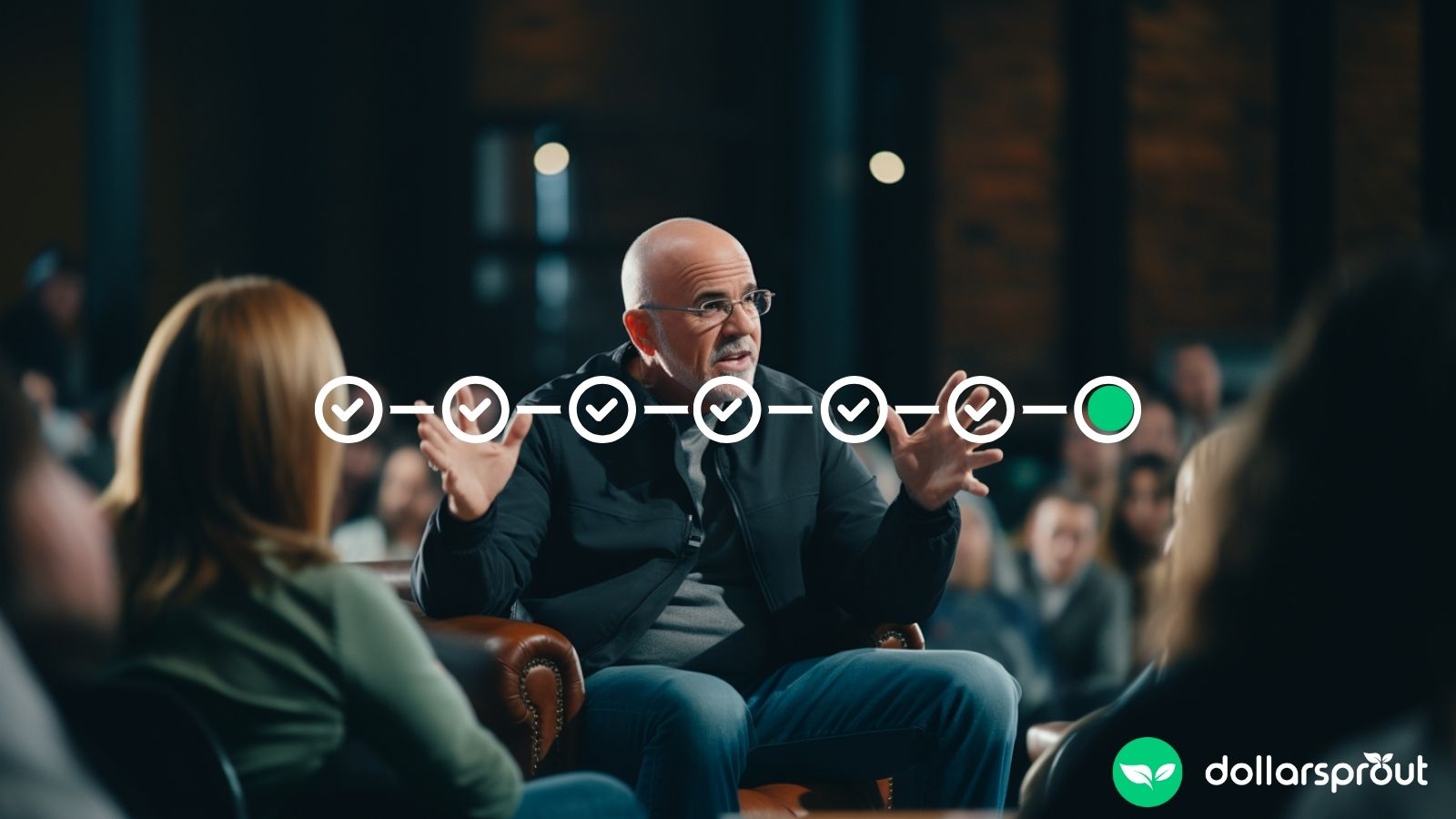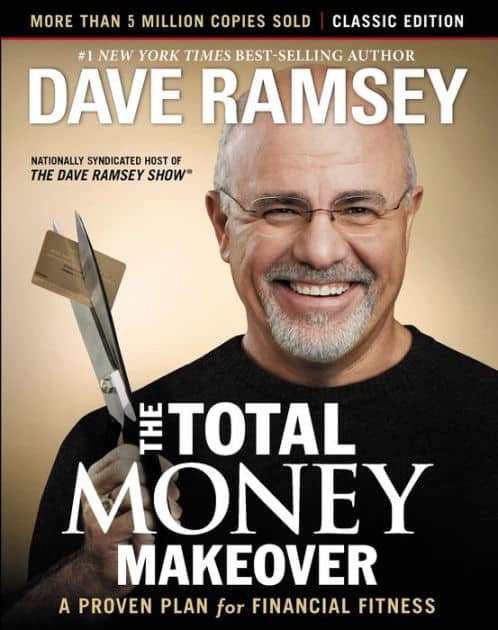Dave Ramsey’s 7 Baby Steps: What Are They and Do They Actually Work?
Our readers always come first
The content on DollarSprout includes links to our advertising partners. When you read our content and click on one of our partners’ links, and then decide to complete an offer — whether it’s downloading an app, opening an account, or some other action — we may earn a commission from that advertiser, at no extra cost to you.
Our ultimate goal is to educate and inform, not lure you into signing up for certain offers. Compensation from our partners may impact what products we cover and where they appear on the site, but does not have any impact on the objectivity of our reviews or advice.
Dave Ramsey's 7 Baby Steps have helped thousands of people around the world to get out of debt. He blends together tough love, religion, and money management advice that helps people fix their financial habits and choices.

Some of the links on DollarSprout point to products or services from partners we trust. If you choose to make a purchase through one, we may earn a commission, which supports the ongoing maintenance and improvement of our site at no additional cost to you. Learn more.
If you’re in debt, you know how much of a problem it can be.
Debt can claim a large amount of your income, making it harder to balance your budget. And it’s an increasing problem among Americans. Almost 30% of Americans don’t have any emergency savings at all, according to a 2019 Bankrate survey.[1]
If you don’t have any savings, you might need to rely on things like credit cards to pay for emergencies. According to a ValuePenguin study, the average U.S household debt is $5,700 and among credit card balance-carrying households, that number jumps to $9,333.[2]
That means that many families are spending spend hundreds of dollars per month on debt repayment, and thousands of dollars per year on interest
There is a solution to these problems that’s becoming increasingly popular — Dave Ramsey’s Baby Steps, a seven-step process for getting out of debt, saving for emergencies, and improving your overall financial picture.
Who Is Dave Ramsey?
Dave Ramsey is a financial expert who learned how to manage his money after being stuck with a large amount of debt from real estate failures when he was younger.
 He took the lessons and principles he learned and launched his own business coaching others and self-published his book Financial Peace University.
He took the lessons and principles he learned and launched his own business coaching others and self-published his book Financial Peace University.
His business grew from there, eventually rebranding to Ramsey Solutions in 2014, but the focus on teaching people how to get out of debt and take control of their finances remained the same.
Dave Ramsey does this through his books such as The Total Money Makeover and Dave Ramsey’s Complete Guide to Money, and radio call-in show, The Dave Ramsey Show.
He also spreads his message through Financial Peace University, which are online or in-person financial classes held in churches around the country.
Ramsey also broadcasts his radio show as a YouTube channel.
Dave Ramsey has helped thousands of people around the world get out of debt. He blends together tough love, religion, and money management advice that helps people fix their financial habits and choices.
What Are Dave Ramsey’s 7 Baby Steps?
The cornerstone of all of his teachings is the Dave Ramsey Baby Steps. These are a series of actionable steps that you complete one by one to progress toward a healthier financial life.
Baby Step 1 – Save $1,000 in an emergency fund
One of the reasons people get into debt is because they’re not prepared to deal with emergencies. Thus, by saving up a small emergency fund, you can buffer yourself against having to rely on credit cards or personal loans the next time your car breaks down or your cat gets sick.
In this step, Dave Ramsey recommends saving up a starter emergency fund of $1,000. This isn’t meant to be your long-term emergency fund if you lose a job or become unable to work. That step comes later, but for now, this smaller emergency fund should do.
The things you need to do to complete this step will set the stage for your success further down the line. You’ll learn how to budget to make sure you’re earning more than you’re spending, allowing you to save the money you need for your emergency fund. This will also help you break out of the paycheck-to-paycheck cycle.
Dave Ramsey is a big proponent of becoming “gazelle intense” from here on out. This means cutting every last little expense you can, living frugally on meals of rice and beans, and cutting cable and other entertainment expenses.
At the same time, you’ll do everything in your power to increase your income. Dave Ramsey routinely recommends selling whatever you can and finding a second job. He even suggests that busy parents deliver pizza or drive for Uber on the side.
Baby Step 2 – Pay off all non-mortgage debt using the Debt Snowball
For many people, Baby Step 2 is the biggest challenge and the step that takes the longest time. In this step, you’ll focus on paying off all of your debt except for your mortgage using a technique known as the debt snowball.
To implement the debt snowball method, you make a list of all of your debts and organize them by balance, with the smallest one at the top of the list and the largest at the bottom. After paying your basic living expenses every month, you put all of your extra money toward your debts, starting with the smallest debt first.
This helps you build quick wins, and keeps you focused and committed so that you don’t lose sight of the goal while paying off your larger debts.
If you have a lot of debt, you may be working on this step for a long time. But remember, the more you cut your expenses and the more you increase your income, the faster you’ll get through this step.
Baby Step 3 – Save 3-6 months of expenses
Once all of your debt is paid off you can then focus on saving up a larger, fully-funded emergency fund. This will help you in case of a major emergency, such as having to replace the roof on your home or losing your job. Ideally, with this fund in place, you’ll be prepared to handle just about any emergency without having to rely on taking on debt again.
The changes you’ve made by lowering your expenses and increasing your income in earlier steps should help you complete this step even faster. You’ll need to have a budget set in place to complete this step, for example, because you’ll need to know exactly what your monthly expenses are.
Ramsey recommends setting aside 3-6 months of expenses, not income, because your expenses are what you’ll be paying in the event you lose your job. Besides, saving up 3-6 months’ worth of expenses feels less intimidating than saving 3-6 months’ income.
A good place to store your fully-funded emergency fund is in a separate, high-yield savings account online where you can still access it quickly, but where you can also earn interest
Baby Step 4 – Invest 15% of gross income into retirement accounts
Now that you’re debt-free and have a fully-funded emergency fund, Dave Ramsey’s next step is to start saving for retirement.
If you have a workplace retirement plan, this can be as simple as speaking to your HR department and getting set up for automatic withdrawals. If you’re self-employed or your workplace doesn’t offer a retirement plan, you’ll need to figure out how to do this on your own.
Ramsey recommends investing in four types of mutual funds: growth, growth and income, aggressive growth, and international. This step is overwhelming for a lot of people who aren’t investing professionals, and Ramsey maintains a network of investment advisors to refer people to for more help.
It’s important to note that Dave Ramsey’s picks of investment advisors aren’t entirely unbiased, as these professionals need to pay a fee to Dave Ramsey in order to be endorsed by him.
Baby Step 5 — Save for kids’ college
Many parents want what’s best for their kids, even if that means footing the bill for their college tuition. Taking on student loan debt can saddle your kids with heavy payments and limit their employment options after they graduate. Many parents want to prevent this, so it’s important that they save now to pay for college later.
Ramsey recommends saving money every month in a 529 college savings plan or an ESA (Educational Savings Account) in order to get a tax break.
This also keeps your money more protected from withdrawing it for non-college uses, since you can generally only use the money in these accounts to pay for approved college expenses rather than a last-minute vacation.
You can do this step with Baby Step 4 if you have money left over after contributing 15% to your retirement account. Even though your kids are important, Ramsey advocates prioritizing your retirement savings first. Taking on debt isn’t ideal, but it’s an option for your kids to attend college. You, on the other hand, can’t take out a loan for retirement.
If you don’t have kids, you can ignore this step and move on to the next one.
Related: How Your Parents’ Finances Could Become Your Liability
Baby Step 6 — Pay off your home
Mortgage debt works differently from other types of consumer debt, making it easier to put aside until after you’ve got other healthier financial habits in place. You’ll still be continuing Baby Steps 4 and 5 in this step, but now you can focus on getting rid of this last hurdle.
If you’re still paying off your mortgage, now is the time to get rid of it. As you did with your debt in Baby Step 2, you’ll put all of your extra money toward paying down the mortgage on your home.
This allows you to own your own home outright so that you don’t have to worry about mortgage payments as you head into retirement.
Baby Step 7 — Build wealth and give
The last step is to create a legacy by giving back with your money. That can look like helping out friends and family or donating to charitable causes that are meaningful and important to you.
You can also focus on building wealth to live a more comfortable life in retirement, create an inheritance for your kids, or create a foundation to continue your legacy after you’re gone.
It’s your call on how to use your money now that it’s not obligated to debts.
How to Stay Motivated While Working the Baby Steps
These steps seem simple at first, but it’s crucial to have a support system in place to make it past even the first step. You’ll need people around you to keep you determined and focused to make the sacrifices necessary and to work on changing your habits.
Determine your why
You can’t change the way you’re currently doing things unless you have a compelling reason to make those changes. Even if what you’re doing now isn’t working for you the way you want, it’s a familiar routine. To change that requires getting uncomfortable, at least until you’ve established new habits.
So, the first step is to decide why you want to change.
Maybe you see how crippling student debt has been to your life and you want something better for your kids. Or maybe you’re embarrassed about how your credit cards keep getting declined when out with friends. Maybe you’re frustrated that you aren’t able to buy your own home with a nice yard for your dog.
Everyone’s “why” looks different, and it’s personal. Yours doesn’t have to look the same as anyone else’s, but it does have to be something that keeps you motivated to progress.
Use visual reminders
Finances are easy to ignore, which is why many people run into problems. Instead, during this process, try bringing yours out into the light
Debt Free Charts are a fun and easy way to track your way to your financial goals. You can also try other creative things, such as creating a paper chain of your debt and removing links as you work your way through Baby Step 2.
You can also hang up pictures of the things that are motivating you to change, such as places you’d like to travel to or homes you’d like to buy someday.
Finally, setting up a budgeting app such as Mint or YNAB on your phone can provide you with alerts and notifications about how you’re spending money throughout the month. These notifications will help you figure out your spending habits and triggers, and can help you change some potentially self-sabotaging behaviors.
Celebrate small wins
Paying off debt can be a long slog. You don’t need to go crazy, but each time you pass a milestone give yourself permission to spend a small amount of money to celebrate it.
Some things you can celebrate are paying off individual debts, or chunks of larger debts. For example, if you have a $50,000 student loan, you can throw a mini-party every time you pay off a $5,000 or $10,000 chunk of that debt. After all, every little step gets you closer toward your debt-free goal, and it’s important to recognize your hard work and accomplishment.
However you choose to celebrate, whether it’s with a massage, fancy dinner out, or a new wallet, the important thing is to have fun with it. These small celebrations give you the momentum and incentive to keep going.
Build rewards and splurges into your budget
When you’re working hard to complete the Dave Ramsey steps, you’ll be living on a tight, “gazelle-intense” budget. This means that you cut every expense you can so that you can put as much of it toward completing each Baby Step as possible.
This isn’t sustainable in the long run, especially if you’re dealing with a large amount of debt on a low income. To make it sustainable, build small rewards and splurges into your budget. These give you something to look forward to and a reason to keep working toward your goal.
The key here is “small” rewards and splurges. For example, you don’t need to forego vacationing for the next several years until you’re entirely debt-free. Instead, you can choose a more cost-effective vacation such as camping or visiting friends and family members.
You can also create a small line item in your budget for movie tickets, buying books, or whatever your hobbies are. Try substituting your expensive habits, such as dining out, with cheaper ones like going out for a happy hour or one drink or using Groupon to save money.
Find a support system
Going through all of Dave Ramsey’s Baby Steps is difficult if you’re doing it alone. That’s why it’s a good idea to find people who can support you, whether they take part in celebrating your wins or act as an accountability buddy who is doing the program alongside you.
This is one reason why many people prefer to do Dave Ramsey’s Financial Peace University in-person with their local church. Going through the program together with other families, learning about the techniques, and growing together can be a very powerful motivator to help you keep going when things get tough.
It can also help to spend time around people doing the same thing as you, who can encourage your new habits and choices, rather than those who encourage the behaviors that put you in your situation.
Related: How to Avoid Lifestyle Inflation When Your Salary Increases
Why People Love the 7 Baby Steps
The strength of Dave Ramsey’s 7 Baby Steps is that it’s broken down into a one-size-fits-all action plan that almost anyone can do. It’s time-tested, and many people have used this plan as a guide to become debt-free over the years.
The backbone of Dave Ramsey’s plan is that it’s easy to follow, easily accessible, and eliminates much of the heavy decision making involved in getting a handle on your finances. He tells you step by step what to do and the order in which you should do it. You can also access online tools and calculators to help keep you on track with his Baby Steps.
There’s no shortage of available information and connections.
You can find a large community of people who follow Dave Ramsey and are going through the program. You can connect with them online through social media, in community forums, or even in-person if you go through Financial Peace University. This support group helps carry many people forward.
There are also live events to attend to connect with other fans and followers of his Baby Steps plan.
Overall, it’s a simple, accessible plan. You follow the steps in order and you’re debt-free. There’s nothing else to do or consider.
What the Critics Have to Say
Dave Ramsey’s 7 Baby Steps face a lot of criticism, especially from financial professionals. Most of the complaints stem from the fact that following a one-size-fits-all plan leaves no room for customization or individual circumstances. And since not everyone’s financial situation is the same, not everyone can use this type of financial plan.
It might get you toward your goal, but it might not be the fastest, most cost-effective, or financially sound way to do it.
For example, Ramsey recommends that you avoid saving for retirement until you’ve paid off all of your non-mortgage debt, even if that means foregoing a company match on your savings. That’s a big no-no among financial professionals because you’re essentially giving up free money. You’ll fall further behind in your retirement savings at a time when most people already aren’t saving enough.
He also makes no distinction between good vs. bad debt, only that debt should be avoided at all costs. This can be a costly mistake if someone has the aptitude for a high-earning career as a doctor or software engineer, for example, but can only do it by taking out student loans that they’d quickly be able to pay off.
Finally, Dave Ramsey frequently comes under fire for recommending only a small $1,000 starter emergency fund. For many people, such as those living in high cost-of-living areas, with large families, or with fluctuating income, this isn’t enough money to protect them while paying off debt.
Although his plan is simple, it’s not without its faults, and you need to weigh those against the ease of following the Baby Steps.
Who Should Use Dave Ramsey’s Baby Steps?
Dave Ramsey provides a color-by-number solution to improving your financial life. He recommends that people strictly follow his plan to save money, with few or no allowances.
This might work for some people, especially those who are confused about determining the best solutions for their financial situation. Since this describes many Americans, it helps explain why Dave Ramsey is so popular. It’s easier to be told, step-by-step, what to do rather than combing through the available advice and information and making a decision.
The reality, however, is that, even if you disagree with some of his advice or the order of the steps, you can use and adapt Dave Ramsey’s Baby Steps for your own situation. You don’t necessarily need to follow his steps exactly or precisely. If you would feel more comfortable with a larger starter emergency fund, for example, or using credit cards to responsibly earn rewards, you can do so.
You can choose to use his advice as a guideline or roadmap rather than an exact plan, but his advice is a good starting point for anyone looking to take control of their finances.








